
We analyze this curious title from the hand of Marvelous, which offers side scrolling exploration with hack’n slash combats and farming mechanics.
Sakuna: Of Rice and Ruin has been a title that has had a long journey from its initial announcement to its arrival in stores, which will take place on November 20 in Europe, while Americans and Japanese will be able to taste it in the first half of the year. month. Initially presented at the 2016 Comiket Market in Japan, it did not take long until its appearance in the West was confirmed by XSEED Games and Marvelous, in charge of its distribution in the different territories in mid-2017, marking its departure for the following year for PlayStation 4 and PC. Over time, the game continued its development as the trailers with some of its playable characteristics were being revealed, confirming in between its conversion for Nintendo Switch, confirmed last year, being finally delayed for the current year 2020.
Developed by Edelweiss, a Japanese indie studio whose titles include the shoot’em ups Astebreed and Ether Vapor Remaster as well as the beat’em up Fairy Bloom Freesia, this new title offers a curious mix of exploration phases with hack’n style combats. slash, with a certain style reminiscent of Muramasa: The Demon Blade, along with mechanics in which rice cultivation will gain importance in a somewhat similar way to games like Harvest Moon or Story of Seasons.
The plot of the game presents the young goddess Sakuna who appears on the bridge that connects the world of humans with the Lofty Realm, a place where the different mythological deities of Japan live, saving a group of humans, who have reached that point. place of fortuitous way, of the attack of a bandit. However, the situation is complicated when returning to the capital of the kingdom, Mihashira, the same group of humans appears who are looking for food, which takes them to the celestial barn where Sakuna ends up accidentally setting fire to the place and provoking an explosion that devastates the offerings destined for the goddess Kamuhitsuki. Consequently, Kamuhitsuki shows up and orders Sakuna to leave quickly to the island of Onijima to investigate the growing presence of demons, being accompanied by the group of humans, consisting of the samurai Tauemon, the young Kinta and Yui, the novice Myrthe and little Kaimaru, making his banishment effective as punishment until he fulfills his mission.
The development of the game will be divided into two different aspects, the first of them being dedicated to exploring the island through the incursion in various areas where materials can be obtained and also face various types of enemies that will make it difficult to progress, as well as providing in certain cases ingredients to cook when defeating them. The second, for its part, will focus on the cultivation and care of the small plot of the house where Sakuna and the group of humans settle, through mini-games and Quick Time Event style sequences.
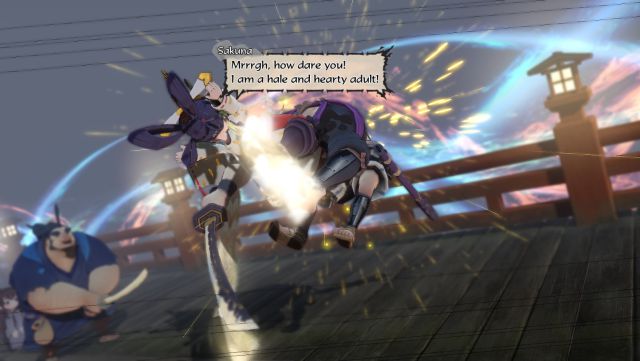
The action takes place through the different seasonal periods, which are divided through cycles of three days, and which will affect the environment, including climatic changes, something that will especially affect the conditions of the crop field. The house that once belonged to Sakuna’s parents, located in the center of the island, will serve as a base of operations and access to some important features during the adventure. From this point, from where the adventure begins in each period, you can access the world map entered from the pause menu and then select the area to visit to start taking action.
The exploration offers a side-scrolling-style perspective in which you advance through differently designed areas in which to overcome obstacles, such as blockages or unevenness, while facing enemies. The combat system in the confrontations offers a very accessible hack’n slash cutting system in which Sakuna will be able to alternate fast attacks with other forceful ones to perform chains of blow combinations with which to gradually reduce the life of the enemies, having the option of executing a parry technique to temporarily stun enemies by timing appropriately and also dodge attacks using the celestial cloak, allowing you to gain back and outmaneuver enemies while also being used to grab ledges in areas taller, as long as it is within the range of action.

On the other hand, Sakuna will be able to learn attack skills, which must be equipped from the game’s pause menu, and whose use in practice is similar to that seen in the Tales saga games, combining buttons next to stick directions to execute each of them while consuming part of an energy bar, which will gradually recharge over time. Likewise, skills related to the use of the celestial mantle in combat can be learned in such a way that they can be used to gain an advantage and fight against the enemy hosts. It is worth mentioning that Sakuna’s powers will be limited at nightfall, because the enemies, sheltered in the darkness of the moment, will have a greater offensive power that will be difficult to defeat at the outset, although as the adventure progresses, objects that they will help to carry out crossings in these conditions.
To progress in the game and open new areas, it will be necessary to fulfill the objectives offered by each one of them, from defeating a specific number of enemies, in a particular way, getting an object or discovering hidden objects, which will increase the indicator of Research the area progressively until it reaches its maximum. Some of the areas to visit in the game will include several sections, including portals that will allow you to resume the progression of the area from that point, from which you will return to the main map and from there, if necessary, return home. . On the other hand there will also be confrontations against monsters of great power that will act as bosses and that defeating them will be a bit complicated as you have to dodge their attacks and those of the host of monsters that will accompany you and complicate the fight.
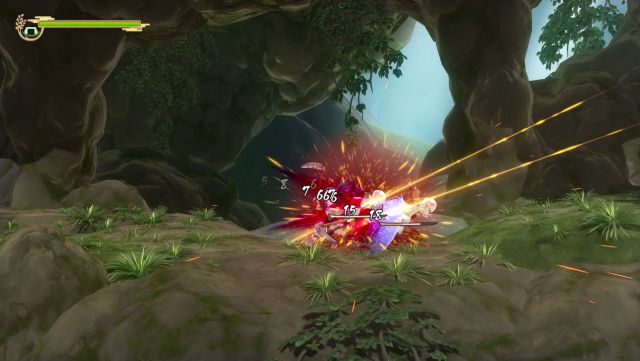
When defeating the enemies, they will drop pieces of amber as well as ingredients, the latter being essential for the group to survive but having as an impediment a short expiration, measured in days, period after which the object becomes part of the rotten food reserves as an ingredient, which can be used for another purpose. To avoid this being frequent, you will have to talk to Myrthe who will offer options related to the kitchen, including preservation with which to eliminate this limit and gradually increase the reserves of stored food. Another option allows you to configure the menu for dinner, having the option to choose between four dishes, one main, two for garnish and a dessert plus a drink, being able to balance them to alter the effects it will have on Sakuna’s parameters and abilities. additional bonuses it will provide, which will last on the field until the onigiri-shaped hunger icon next to the health bar is completely empty.
The materials obtained can be used for different purposes, among them being able to make new weapons and armor through the options that, once unlocked when advancing in the game, will allow Kinta and Yui, respectively, to be in charge of the manufacture of these pieces. of equipment, being necessary to offer the materials required to be able to manufacture them. Denote that apart from having better characteristics, such as increased attack or defensive power, these objects will occasionally include passive abilities that will be blocked from entry, being necessary to perform a specific task to be able to activate their power through the equipment menu and access to your benefits.
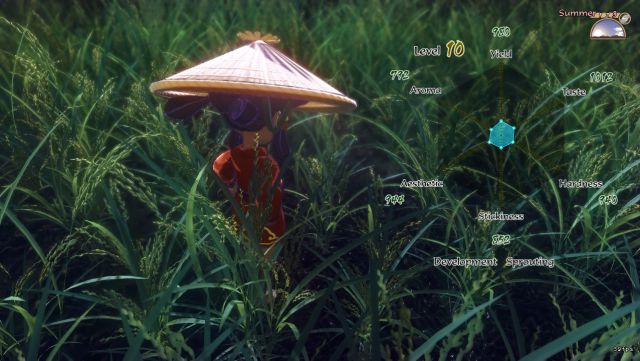
As for the farming part, its development will be important during the game since, on the one hand, it will allow to get food in good quantity with which to increase the benefits to bring to Sakuna in combat, while on the other it will be vital in the sense of that will help to increase the level of the goddess and improve her parameters accordingly, which will allow her to face combat situations against more powerful or complex enemies.
The development of this part of the game is carried out through various activities that are carried out through mini-games and button-pressing sequences (Quick Time Event), having to carry out the details of the cultivation process in several stages. This will include from the plowing of the land at the beginning of summer and later the cultivation of seeds until harvesting the harvest at the end of autumn and later shelling it and separating the shells, going through controlling the temperature and the water level, fertilizing the land or removing insects and plants that may negatively affect the process. In principle, carrying out these tasks will be somewhat complicated, partly because of some strange controls for some activities and, secondly, because of the few notions that are learned from the start, but as the process progresses repeatedly, some will be obtained. Advantages in the form of skills that can be used immediately to facilitate the work and through the scrolls left by Toyohana, Sakuna’s mother, which can be consulted by talking to Tauemon.

One of the relevant aspects within the cultivation process is to fertilize the land to strengthen the harvest and therefore its quality at the end of the season, having the possibility of manufacturing the mixture and achieving different effects. This is achieved by mixing the debris, which is collected from the latrine located near the house, together with other components, including the pieces of amber obtained or other special materials, which will serve to increase the properties of the starting mixture, which which may affect making it stronger in each of the three available categories (seeds, roots and leaves). Later, materials can be added, from rotten food to other materials obtained in explorations, to the mix that will help increase other parameters in a positive way, such as its strength, life points or magic among other aspects, or affect in a certain way negatively, as in the case of adding certain materials that will reduce the level of resistance against pests, for example. Once the components have been chosen, it remains to leave the mixture to rest for a period of time and then spread it on the ground, something that is done automatically.
Throughout the cultivation period, the information on the progress of the harvest can be consulted at the beginning of each day, marking the level it has at all times as well as being able to go to the field and see the data regarding the effect of the fertilizer or the progression of Each plant. The inclement weather will affect depending on the season, especially with copious rains during the season, which will help the harvest to have a good proportion of water, something that in turn can be controlled through the two gates, one to make way to the water and the other to empty the excess of it, which will show the information of the water level of the land and the temperature of the same. At the end of the season, the assessment of the harvested crop and the improvement it will bring to Sakuna will be offered, apart from offering extensive information on the process including others of a diverse nature.
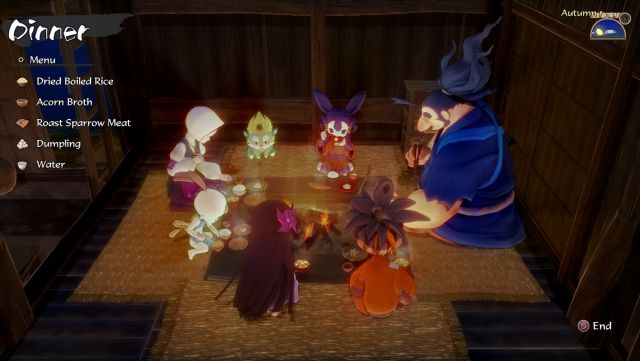
During the game, sequences with the game engine will occasionally be displayed in which the characters will show their day-to-day life on the island, either through secondary events or others that will serve to propose various commissions for Sakuna, most of the time requiring a series of materials or, failing that, investigating certain areas in order to progress in the adventure. On the other hand, the dinner parties, apart from showing the group tasting the food, will also serve to learn background data of the different characters through text conversations in which somewhat relevant data will even be detailed, such as the adventure that Sakuna’s parents lived.
In terms of playability, the game stands out in the fighting facet for offering an accessible and easy-to-master game system with which to chain sequences of blows and make eye-catching combinations against the different types of enemies that populate the island and the bosses, achieving a point that is addictive to play. As for the farming part, although it is a bit tedious at first, in the long run it ends up being interesting to see the progress and the details of the evolution of the harvest. The skills help facilitate progression in this regard and the minigames, despite giving a strange feel to the controls, end up being curious.
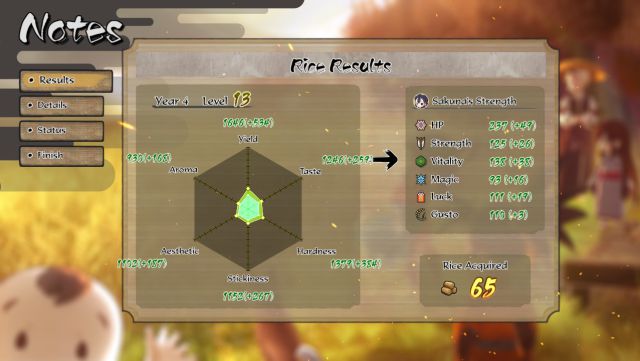
Regarding the graphic section, the game offers 3D graphics for both character modeling and scenarios, combining total control perspectives with a free camera with others, in the exploration phases, in a side scrolling style. The character designs stand out especially for their simplicity but also for having a striking style, which although shows the signs of the anime style, offering a different counterpoint to what is usually seen. For their part, the scenarios offer different ecosystems, from caves to places with fantastic details, in which the different weather conditions will be reflected that will alter their appearance, the same happening in Sakuna’s house.
The sound section of the game offers a wide variety of compositions ranging from sober and calm melodies to others with a more casual style or others with a touch more appropriate for moments of action in the middle of the fight against a boss. Most of these pieces show off chords that evoke sounds typical of Japanese folklore and that accompany them at all times without standing out excessively but neither remaining in an inconsequential plane. For its part, the game allows you to select between dubbing in English and Japanese.
Score: 8.2
CONCLUSION
Sakuna: Of Rice and Ruin translates into an interesting title that stands out especially for the mixture of mechanics that it offers through its development with an exploration part in which the combat system is its main virtue thanks to its simplicity of control and easy to chain combos such as farming mechanics in which you see the process of growing rice through various mini-games. This, added to a cast of characters where Sakuna, the protagonist of the story, and the musical variety offered by the game’s soundtrack especially stand out, make up a game aimed at fans of Japanese games.
THE BEST
- The combat system, which allows easy control to make combinations of attacks as effective as they are colorful.
- The part of farming, which is interesting as the game progresses through the different tasks involved.
- The cast of characters that stand out for their personality and charisma, especially Sakuna.
- The soundtrack, with a wide variety of musical compositions with sounds typical of Japanese folklore.
WORST
- Texts only in English.
- It can get a bit repetitive in the long run.
